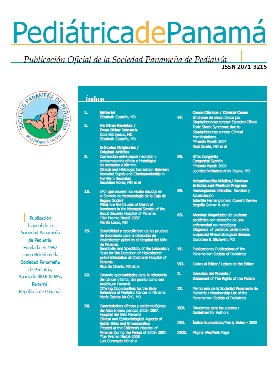Una niñez bien vivida
Autores/as
DOI:
https://doi.org/10.37980/im.journal.rspp.20201594Palabras clave:
niñez, vivencia, bioéticaResumen
Este documento no tiene resumen. Se presenta los primeros párrafos del texto completo.
¿Por qué algunos adultos miran atrás en sus años de infancia y encuentran afecto, mientras otros, ansiedad y dificultades? Es bien conocido en salud mental, el resultado negativo que los eventos adversos experimentados en la niñez introducen en la vida del ser humano. La depresión, el trastorno de uso de alcohol y drogas, el pensamiento y comportamiento suicida, todos tienen raíces en aquel escenario de muchos actos. ¿Cuánto de todo este resultado pasa desapercibido por los padres y los maestros?
Al menos, en un estudio llevado a cabo en agosto de 2019 por C.S. Mott Children’s Hospital[1], entre 819 padres de familia, para un 40% de los padres resulta difícil reconocer la depresión en sus hijos, un 30% lo atribuyen a que los hijos lo saben ocultar muy bien, un 14% acepta que entre ellos, padres e hijos, se conversa poco o se está poco tiempo juntos, dice un 7% de los padres. Interesante que solo un 4% refiere desconocer los signos de depresión que hay que buscar.
Quizás, lo ético emerge como resultado de un cuidado más amoroso, menos agresivo, menos exigente o competitivo, más gentil y cariñoso.
Al mismo tiempo, la inequidad[2] labra y acentúa -cuando no inicia- un escabroso camino de desesperanza más visible en los años de la adolescencia, cuando llega un momento que no se distingue si las experiencias adversas son el resultado o son la causa de aquellos trastornos de la salud. Es también el período de tiempo de mayor vulnerabilidad del cerebro humano a la exposición de lo que resulta en detrimento.[3]
En un escrito provocativo, Luara Ferracioli[4], profesora de filosofía política en la Universidad de Sydney señala que, para el niño, crecer bajo la despreocupación es intrínseco a una vida bien vivida, o una vida feliz. Recuerda que estas vidas son diametralmente diferentes a las dominadas por el stress y la ansiedad, que dominan las de los adultos. Una de tantas respuestas, seguramente, a la pregunta que inicia este escrito.
El pediatra, un hombre o una mujer adultos, que ha vivido y gozado su relación con los niños, que se ha identificado con ellos tantas veces, se comporta como ellos en cuanto a revelar alegría en su rostro y en sus actos cada vez que comparte con ellos. Contrasta claramente con los rostros y los comportamientos rígidos más que preocupados, severos más que cuidadosos de otros adultos de otras labores o profesiones.
Hace unos años atrás, coincidí en una gasolinera para ponerle gasolina a mi auto, con el padre divorciado de dos pacientes mías. En aquel momento ellas tenías 7 y 5 años de edad. Se bajaron de su auto y vinieron corriendo hacia mía para abrazarme y enseguida jugué con ellas “al escondido”. Nunca puedo olvidarme la alegría en sus caritas y la expresión violenta de su padre hacia mí: “¡pareces un niño!”. Yo tendría cerca de los 50 años de edad. Puede darle las gracias, pero realmente era una de sus tantas características de su comportamiento y, seguro, un buen argumento para divorciarlo. Pero eso es cierto, jugamos con los niños y reímos con ellos, no importa nuestra edad, puntualmente cuando le permitimos a la despreocupación gozar de la alegría de los momentos y de los niños. Esas niñas querían reír, querían jugar, querían un rato de felicidad. ¿Por que no dárselos? Hay algo especial en despreocuparse, que es necesario para permitir una niñez bien vivida.
[1] Mott Poll Report. C.S. Mott Children’s Hospital, the University of Michigan Department of Pediatrics, and the University of Michigan Susan B. Meister Child Health Evaluation and Research (CHEAR) Center. 2019. November 18, vol 3: Issue 2
[2] Inequity and Adolescence. En: The Promise of Adolescence. Realizing Opportunity for All Youth. Consensus Study Report. The National Academies of Sciences – Engineering – Medicine. The National Academies Press. 500 Fifth Street, NW. Washington DC 20001: Ch 4: 95-145
[3] Galvan A: The Neuroscience of Adolescence. Cambridge Fundamentals of Neuroscience in Psychology. Cambridge University Press. 2017
[4] Ferracioli L: For a child, being carefree is intrinsic to a well-lived life. AEON Newsletter. 08 May, 2020
Publicado
Número
Sección
Licencia
Derechos de autor 2020 Infomedic InternationalDerechos autoriales y de reproducibilidad. La Revista Pediátrica de Panamá es un ente académico, sin fines de lucro, que forma parte de la Sociedad Panameña de Pediatría. Sus publicaciones son de tipo gratuito, para uso individual y académico. El autor, al publicar en la Revista otorga sus derechos permanente para que su contenido sea editado por la Sociedad y distribuido Infomedic International bajo la Licencia de uso de distribución. Las polítcas de distribución dependerán del tipo de envío seleccionado por el autor.





 Suscripción a Novedades
Suscripción a Novedades